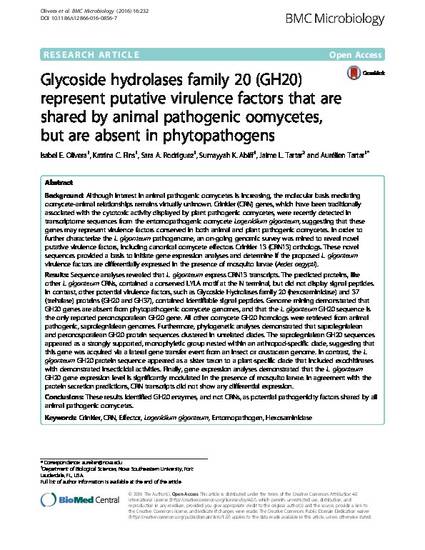
- Crinkler,
- CRN,
- Effector,
- Lagenidium giganteum,
- Entomopathogen,
- Hexosaminidase
- Biology and
- Life Sciences
Background
Although interest in animal pathogenic oomycetes is increasing, the molecular basis mediating oomycete-animal relationships remains virtually unknown. Crinkler (CRN) genes, which have been traditionally associated with the cytotoxic activity displayed by plant pathogenic oomycetes, were recently detected in transcriptome sequences from the entomopathogenic oomycete Lagenidium giganteum, suggesting that these genes may represent virulence factors conserved in both animal and plant pathogenic oomycetes. In order to further characterize the L. giganteum pathogenome, an on-going genomic survey was mined to reveal novel putative virulence factors, including canonical oomycete effectors Crinkler 13 (CRN13) orthologs. These novel sequences provided a basis to initiate gene expression analyses and determine if the proposed L. giganteum virulence factors are differentially expressed in the presence of mosquito larvae (Aedes aegypti).
Results
Sequence analyses revealed that L. giganteum express CRN13 transcripts. The predicted proteins, like other L. giganteum CRNs, contained a conserved LYLA motif at the N terminal, but did not display signal peptides. In contrast, other potential virulence factors, such as Glycoside Hydrolases family 20 (hexosaminidase) and 37 (trehalase) proteins (GH20 and GH37), contained identifiable signal peptides. Genome mining demonstrated that GH20 genes are absent from phytopathogenic oomycete genomes, and that the L. giganteum GH20 sequence is the only reported peronosporalean GH20 gene. All other oomycete GH20 homologs were retrieved from animal pathogenic, saprolegnialean genomes. Furthermore, phylogenetic analyses demonstrated that saprolegnialean and peronosporalean GH20 protein sequences clustered in unrelated clades. The saprolegnialean GH20 sequences appeared as a strongly supported, monophyletic group nested within an arthropod-specific clade, suggesting that this gene was acquired via a lateral gene transfer event from an insect or crustacean genome. In contrast, the L. giganteum GH20 protein sequence appeared as a sister taxon to a plant-specific clade that included exochitinases with demonstrated insecticidal activities. Finally, gene expression analyses demonstrated that the L. giganteum GH20 gene expression level is significantly modulated in the presence of mosquito larvae. In agreement with the protein secretion predictions, CRN transcripts did not show any differential expression.
Conclusions
These results identified GH20 enzymes, and not CRNs, as potential pathogenicity factors shared by all animal pathogenic oomycetes.
Available at: http://works.bepress.com/aurelien-tartar/51/

© 2016 The Author(s). Open Access This article is distributed under the terms of the Creative Commons Attribution 4.0 International License (http://creativecommons.org/licenses/by/4.0/), which permits unrestricted use, distribution, and reproduction in any medium, provided you give appropriate credit to the original author(s) and the source, provide a link to the Creative Commons license, and indicate if changes were made. The Creative Commons Public Domain Dedication waiver (http://creativecommons.org/publicdomain/zero/1.0/) applies to the data made available in this article, unless otherwise stated